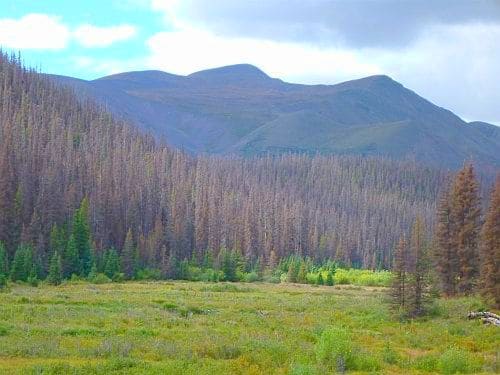
(the Denver Post has good stories on our topics but the website is THE MOST ANNOYING of any in the ones we link to, IMHO). Also, I get the print edition and there was a map and a table about insects that don’t show up online(??).
National Forest overseers on Tuesday targeted 45 million acres in 35 states — 9.6 million acres in Colorado — for accelerated work dealing with insects and disease that are weakening forests and raising wildfire risks.
But the challenge is growing in Colorado as epidemic ravaging by one bug, the mountain pine beetle, leads to a rapidly expanding outbreak of another, the spruce beetle, which has infested 1.14 million acres across southwestern Colorado.
and
Agriculture Secretary Tom Vilsack on Tuesday announced the designation of the national forest land for accelerated projects to combat insect infestations and disease. Forest overseers are embarking on a streamlined review process for projects aimed at controlling epidemics and restoring balance.
“More needs to be done,” Vilsack said, noting the role of forests as the source of water, as recreation havens that draw 166 million visitors and as generators of 200,000 jobs.
Accelerating the battle against insects and disease dovetails with budgeting changes — pushed by Colorado Sens. Michael Bennet and Mark Udall — to prevent the raiding of forest health funds for wildfire suppression when fires become catastrophic.
Vilsack has requested the creation of a $954 million disaster fund for the worst 2 percent of wildfires, ensuring Forest Service funds for work to combat insect epidemics, disease and restoration of overly dense forests.
Vilsack also announced the addition of four firefighting aircraft, bringing the total to 21 large tankers and about 113 helicopters as drought across the Southwest and California leads to heavy wildfires. Firefighting aircraft, if deployed early, can be effective in snuffing potential mega-fires.
“The breathing room is only going to come when we don’t have to rob Peter to pay Paul,” Vilsack said in an interview with The Denver Post. “It’s a return to days gone by when you had a budget where a substantial percentage was going to restoration efforts and a small percentage was going to fire suppression. That’s been flipped on its head now. You’ve got 40 percent of your money going toward fighting fires. And because you are robbing money from restoration, that percentage is just going to continue to increase.
“The only way you deal with it is you reduce the risk. The only way to reduce the risk is by doing a better job of restoring and making your forests more resilient. And you can’t do that unless you have the resources.”
I hope Bruce Finley, the author, put in the “restoring balance” part, although I don’t think the “balance” idea should even still be out there in the public. That goes back to Botkin’s book (see sidebar).
While I think “restoration” has some conceptual issues, I do think “making forests more resilient” is a great way of talking about it. Yay, public affairs folks!
Anyway, attached is more detailed information that USDA is sending around the effort. Andy, note that airplanes are part of the response ;).
AcresDesignatedByStateForestAndCongressionDistrict-may16
Healthy_Forest_Restoration_Act_Designations_NationalMap_May162014
Insect and Disease Communications and Rollout Package FINAL
And here’s a Rocky Barker story that shows the relationship to the Farm Bill (as does the USDA press release):
The new Farm Bill amends the Healthy Forest Restoration Act of 2003 to allow the Forest Service to more quickly plan projects for insect and disease treatments within designated areas, in an effort to increase the pace and scale of restoration across the National Forest System. Using the new tools in the Farm Bill, restoration projects in these designated areas have to be developed in collaboration with a diverse group of stakeholders and must meet environmental safeguards.
Personally, I don’t think the Forest Service can accomplish much, being so top-heavy. Every year they lose knowledge and skills, having to “reinvent the wheel” before doing anything substantial. Future generations are just going to have to suffer for our feeble responses to unbalanced ecosystems. “Whatever Happens” will happen and we will always be one step (or more) behind.
Here’s how the planning rule defines “restoration:” “The process of assisting the recovery of an ecosystem that has been degraded, damaged, or destroyed. Ecological restoration focuses on
reestablishing the composition, structure, pattern, and ecological processes necessary to facilitate
terrestrial and aquatic ecosystems sustainability, RESILIENCE, and health under current and future conditions.” Not a new idea.
I did see some VERY interesting non-commercial, fuels reduction work around Panguitch, Utah (during my trip to the area’s National Parks), outside of the National Forest. Utah continues to have drought-related problems with their National Forests, too.
https://www.google.com/maps/@37.7427641,-112.4110334,3604m/data=!3m1!1e3?hl=en
I’m sorting out my pictures from the trip and posting some at http://www.facebook.com/LarryHarrellFotoware